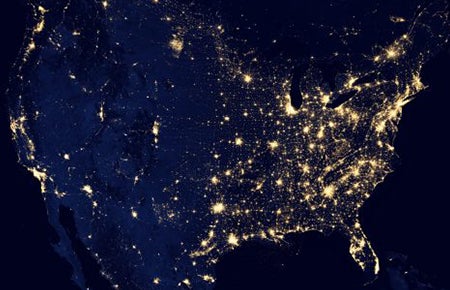
Scientist’s new database can help protect wildlife from harmful hues of LED lights
On beaches around the world, tiny loggerhead sea turtle hatchlings — now an endangered species — continue to leave their nests at night as they have done for the last 100 million years. But instead of skittering across the damp sand to the ocean, the baby turtles are following artificial LED lights inland to danger.
Nor are the baby turtles alone in facing a threat from this new generation of outdoor lighting. LED lights attract migrating juvenile salmon, exposing them to predators, while global declines in insects have been linked in part to light pollution.
USC Dornsife’s Travis Longcore is leading a team of biologists who have developed a new tool to help fix the problem.
The team of biologists surveyed select species around the world to determine how the hues of modern light-emitting diode (LED) lamps affect wildlife. They found that blues and whites are most dangerous for wildlife — some affect species as much as an equal brightness of midday sun and three times more than yellow or green lights designed with wavelengths less disruptive to wildlife. Some creatures, including sea turtles and insects, are especially vulnerable.

A composite of satellite images shows nighttime illumination from the use of electric lights in the United States in 2012. Image by NASA.
The findings, which include the first publicly available database to help developers, designers and policymakers choose wildlife-friendly lighting colors, appeared in the June issue of the Journal of Experimental Zoology Part A: Ecological and Integrative Physiology.
“Outdoor environments are changing rapidly and in ways that can impact wildlife species,” said Travis Longcore, lead author of the study and assistant professor of biological sciences and spatial sciences with the Spatial Sciences Institute at USC Dornsife and architecture at USC School of Architecture. “We provide a method to assess the probable consequences of new light sources to keep up with the changing technology.”
Big cities and industrial sites illuminate the night sky to such an extent now that much of Earth resembles a big, glowing ball. Scientists have spent years studying how light brightness and direction affects wildlife, including migration and attraction, predator-prey relationships and circadian rhythms. The USC Dornsife team used that existing ecological data and broke new ground by examining how a range of commercially available LED lights impact species.
Animals and LEDs of many colors
LED lights are expected to make up 69 percent of the global market by 2020, compared to just 9 percent in 2011. They are popular because they have many uses, conserve energy and last longer.
To understand the impacts and find compromise solutions between human and animal needs, the researchers focused on four groups of creatures, which have been studied for light responses previously: insects, sea turtles, salmon and a seabird called Newell’s shearwater. Future studies will incorporate more species worldwide.
Conservation
A central component of the USC Dornsife research includes the first publicly available database showing how about two dozen different types of artificial lighting affect wildlife. The matrix is called “Rapid Assessment of Lamp Spectrum to Quantify Ecological Effects of Light at Night.” Developers, land-use planners and policymakers can use it to choose lighting that balances the needs of nature and people. Today, regulations to limit light direction or intensity typically don’t account for the different hues of LED lights, Longcore noted.
“If we don’t provide advice and information to decision makers, they will go with the cheapest lighting or lighting that serves only one interest and does not balance other interests,” he said. “We provide a method to assess the probable consequences of new light sources to keep up with the changing technology and wildlife concerns.”
About the study
The study authors include Longcore; Airam Rodríguez of the Estación Biológica de Doñana CSIC in Spain; Blair Witherington of The Walt Disney Co.’s Animals, Science and Environment program; Jay Penniman of the University of Hawaii at Manoa, Pacific Cooperative Studies Unit; and Lorna and Michael Herf of f.lux Software LLC.
C&W Energy Solutions LLC provided seed funding for the investigation but did not participate in research or reporting results. Rodríguez was supported by a Marie Curie International Outgoing Fellowship (330655 FP7-PEOPLE-2012-IOF) and a Juan de la Cierva contract from the Spanish Ministry of Economy, Industry and Competitiveness (IJCI-2015-23913).